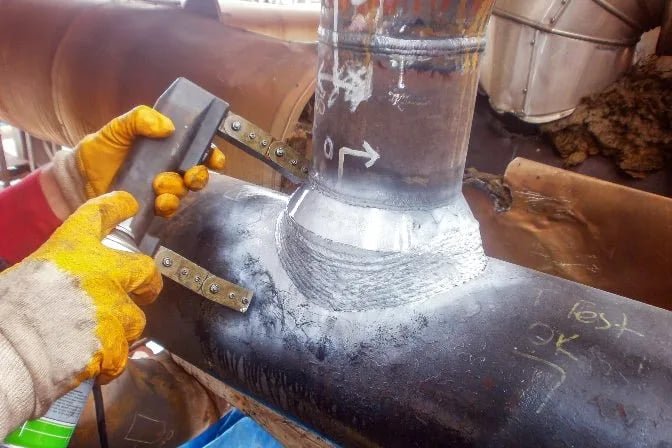Experience Quality: Premier Pipeline Welding Inspection Providers You Can Trust
Experience Quality: Premier Pipeline Welding Inspection Providers You Can Trust
Blog Article
Comprehensive Review of Pipeline Welding Examination Procedures
Pipe welding examination treatments play a crucial role in assuring that bonded links meet stringent market standards and specs. From meticulous pre-welding evaluations to comprehensive post-weld assessments, a distinct evaluation process is important for preserving the architectural strength of pipelines.
Pre-welding Inspection Preparations
Prior to beginning the welding procedure, thorough pre-welding assessment prep work are vital to make sure the integrity and high quality of the weld joint. These prep work involve a meticulous exam of the materials to be bonded, the welding devices, and the work atmosphere. By carrying out detailed pre-welding inspection preparations, possible concerns can be determined and fixed early on, leading to trusted and premium weld joints.
Welding Procedure Qualification
Complete pre-welding examination preparations lay the structure for the crucial procedure of Welding Treatment Qualification, ensuring the honesty and top quality of the weld joint. Welding Treatment Qualification (WPQ) is a vital step in the welding process that involves testing and certifying welding procedures to guarantee they fulfill specific standards and needs. The WPQ process usually includes welding treatment spec advancement, welding treatment certification testing, and documents of the results.
Throughout welding treatment spec development, important details such as the welding procedure, welding products, joint style, and welding specifications are specified to create a detailed treatment. Consequently, welding treatment qualification screening is performed to validate the recommended treatment's honesty. This screening frequently entails welding test promo codes that are subjected to different mechanical and non-destructive examinations to evaluate the weld's high quality and adherence to the defined criteria.
In-process Weld Inspection
During the welding procedure, in-process weld assessment plays an important role in making certain the quality and stability of the weld joint - Pipeline Welding Inspection. This kind of assessment includes checking the welding parameters, examining the weld bead development, and finding any possible issues or interruptions as they occur. By conducting in-process weld inspections, welding drivers can quickly attend to any problems that might arise, consequently stopping further problems and guaranteeing that the last weld meets the needed requirements
Usual approaches utilized for in-process weld evaluation consist of visual assessment, liquid penetrant screening, magnetic fragment testing, ultrasonic screening, and radiographic screening. On the whole, in-process weld evaluation is necessary for maintaining the top quality and reliability of welded pipelines.
Non-destructive Testing (NDT)
Non-destructive Testing (NDT) is an essential approach utilized in pipe welding examination to examine the stability of weld joints without creating damage to the bonded structure. By making use of numerous NDT methods, assessors can examine the high quality of welds and determine any kind of defects or stoppages that might jeopardize the architectural sturdiness of the pipeline. Typical NDT techniques used in pipe welding inspection include Radiographic Screening (RT), Ultrasonic Screening (UT), Magnetic Particle Testing (MPT), Fluid Penetrant Screening (LPT), and Visual Testing (VT)
RT includes using X-rays or gamma rays to generate pictures of the inner framework of the weld, permitting inspectors to spot defects such as porosity, cracks, or incomplete fusion. UT utilizes high-frequency acoustic waves to detect problems beneath the surface area of the weld, using thorough info regarding the size and location of flaws. MPT and LPT are utilized to recognize surface-breaking defects by using penetrant liquids or magnetic particles to the weld area. Furthermore, VT includes visual evaluation of welds to recognize any kind of noticeable imperfections.
Post-weld Inspection and Documents


Documentation of post-weld evaluation searchings for is necessary for maintaining high quality control documents and ensuring conformity with sector standards and guidelines. Comprehensive reports ought to include info concerning the evaluation techniques utilized, the location and nature of any defects discovered, and any corrective actions taken - Pipeline Welding Inspection. Appropriate documents not just works as a document of the weld's top quality but likewise help in future upkeep and assessment processes
Conclusion

To conclude, pipe welding evaluation procedures play an important duty in ensuring the quality and integrity of welds. From pre-welding inspections to post-weld paperwork, each action is crucial in preserving the security and effectiveness of pipes. By complying with well established helpful resources procedures and conducting extensive inspections, prospective problems can be recognized and addressed prior to they cause costly repairs or failures. On the whole, adherence to correct inspection methods is vital to the success of pipe welding projects.
From thorough pre-welding evaluations to comprehensive post-weld evaluations, a distinct evaluation procedure is necessary for maintaining the structural sturdiness why not try this out of pipelines. By conducting in-process weld assessments, welding operators can immediately attend to any issues that may develop, therefore protecting against additional defects and ensuring that the final weld meets the needed specifications.
Typical techniques utilized for in-process weld examination include visual evaluation, liquid penetrant testing, magnetic particle testing, ultrasonic testing, and radiographic screening.Non-destructive Screening (NDT) is an essential approach used in pipeline welding inspection to evaluate the stability of weld joints without triggering damage to the welded framework. Post-weld evaluation entails various approaches to examine the welds for flaws, including aesthetic examination, dye penetrant screening, magnetic bit testing, ultrasonic testing, and radiographic testing.
Report this page